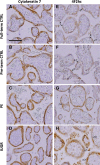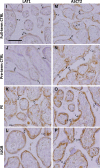Differential levels of amino acid transporters System L and ASCT2, and the mTOR protein in placenta of preeclampsia and IUGR
- PMID: 24886642
- PMCID: PMC4060848
- DOI: 10.1186/1471-2393-14-181
Differential levels of amino acid transporters System L and ASCT2, and the mTOR protein in placenta of preeclampsia and IUGR
Abstract
Background: Sufficient amino acid transport activity (AAT) is indispensable for appropriate fetal growth. Studies suggest that placental nutrient uptake activity is responsive to both maternal and fetal nutrient demands. We hypothesize that under conditions of limited nutrient availability to the fetus, as often present in preeclampsia, intrauterine growth restriction (IUGR), and insufficient weight-gain during pregnancy, a general adaptive response aimed to increase amino acid transport activity may be observed in the placenta.
Method: A total of 40 placentas from full-term (n = 10) and pre-term (average gestational period = 34.8 weeks, n = 10) normal pregnancies, IUGR (n = 10), and preeclampsia (n = 10) associated pregnancies were looked at by immunohistochemistry followed by relative qualitative scoring to compare expression levels and localization of System L, ASCT2, and mTOR proteins.
Result: Microvillous syncytiotrophoblast (ST) in placenta of pregnancies complicated by IUGR or preeclampsia (PE) showed significant increases in the levels of System L amino acid transport proteins 4F2hc and LAT1 compared to both full-term control and pre-term (early gestation control) pregnancies seperately (p < 0.05). Elevated mTOR protein was uniquely higher in IUGR placentas compared to full-term controls (P = 0.0026). Total cellular ASCT2 transporter protein levels were similar in all groups, however, levels of ASCT2 protein localized to the ST microvillous membrane (MVM) were significantly lower in IUGR compared to both full-term and pre-term pregnancies (P = 0.0006, 0.03, respectively). Additionally, ASCT2 and mTOR protein levels were positively associated with maternal pre-pregnancy BMI (P = 0.046, 0.048, respectively).
Conclusion: There are three important findings based upon the present study. First, in conditions of limited nutrient availability, such as PE or IUGR, there is an overall increase in the level of System L and mTOR protein expression in the ST, suggestive of an adaptive response. Second, a decrease in ASCT2 protein at the ST MVM suggests a post-translational event that may decrease AAT activity in IUGR placentas. Third, a physiological link between transporter expression and pre-pregnancy BMI is suggested based upon a positive association observed with ASCT2 and mTOR expression values.
Figures





References
Publication types
MeSH terms
Substances
LinkOut - more resources
Full Text Sources
Other Literature Sources
Research Materials
Miscellaneous

